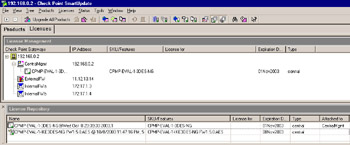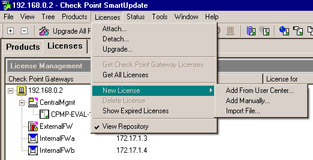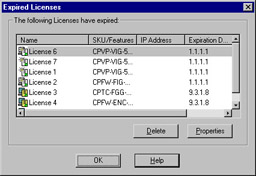SmartUpdate
SmartUpdate is a tool for the easy management of both software updates and licensing for both Check Point and OPSEC products. Chapter 8 covers the version management and upgrade features, but it will not hurt to touch on the licensing here. This component can be a real lifesaver, as you will understand if you have ever had to manually upgrade several dozens of licenses.
The GUI interface features two panels, one for Products and one for Licenses . These can be selected by clicking on the appropriate tab within the window. Figure 3.34 illustrates this GUI panel.

Figure 3.34: SmartUpdate GUI
The real blessing of the SmartUpdate tool is that of centralized management and authority. Using this product, you can apply updates to your Check Point modules in a timelier manner, update licenses, and modify the currently licensed machines. Before you begin doing this, however, you should know about a new feature of FW-1 NG. This feature is called Central Licensing and uses what is known as a license repository.
In previous versions of FW-1 you had only one licensing option, that of a local license. Local licensing mandated that the license be tied to the IP address of the module. This model was not very flexible and made upgrades very difficult and migrations nearly impossible . Central licensing binds the license to the address of the management server and allows several benefits.
-
When you change the IP address of the firewall module, the license remains useable. This has not always been the case.
-
All licenses are bound to only one IP address. This allows great flexibility in your FW-1 deployment. Imagine the scenario where your network boundaries are migrated from one provider to another, and with that comes a new network block. Using central licensing makes that address change a much quicker operation. Licenses can be taken from one module and given to another and managed from this central location.
Note that while local licenses can still be used with FW-1 NG, you will not be able to use them like central licenses. This means that they cannot be detached from their module and reattached to another address after they have been installed.
Before you can begin using the functionality of SmartUpdate product, some common-sense things have to be in place. Obviously, there needs to be connectivity between the management module and the modules that are being maintained . For your purposes, connectivity implies both IP connectivity and FW-1 connectivity (SIC). Once this is all in place, you are on your way to licensing bliss.
Licenses can be added to the license repository in one of two ways. The first, more tedious method is to copy the license details by hand. This is annoying and can lead to typographical errors, (although support exists to paste the license details from the clipboard, removing the need to hand-type) so you probably will not want to add licenses in this way. The second method is to import a file created by the Check Point User Center. The option to Add From User Center is somewhat misleading as you do not actually use this option to add licenses, but rather to fetch them from User Center.
To begin, select Licenses New License from the SmartUpdate tool bar. This will allow you the choice of adding manually, from User Center, or importing from a file. Figure 3.35 illustrates this menu option.

Figure 3.35: Adding a License
If you opt to add the license manually, you will see a window with a slew of fields that you will need to fill out, or as mentioned previously, you can paste the values from the clipboard. If you select Import File , you will see the standard file browse window. The option to acquire the new license from User Center will open a Web browser window. Also under the License menu option is the ability to view the License Repository. The Repository is a listing of all installed licenses and allows a filtered view. It can show you all licenses, all attached licenses, or all unattached licenses. This is a handy way to get a feel for what spare licenses you have, as well as enabling you to attach and detach central licenses. Remember that the old style licenses cannot be moved. (SmartUpdate automatically attaches them to the proper module when they are imported.) Figure 3.36 shows the license repository.

Figure 3.36: License Repository ”View All Licenses
Using the Repository, license administration is as easy as right clicking. In Figure 3.36, you will see all licenses. Notice that several of them are not attached to a specific module. To use these licenses, simply right-click on its entry and select Attach. At this point, you will see a listing of the defined workstations with Check Point modules. Select the desired system and select OK .
One other very helpful feature is the ability to view expired licenses. To do this, right-click anywhere within the Repository window and select S how Expired Licenses . This presents a window (shown in Figure 3.37) listing the licenses that are no longer valid. Selecting an expired license entry and clicking on Properties shows you what module the expired license is attached to.

Figure 3.37: Expired Licenses